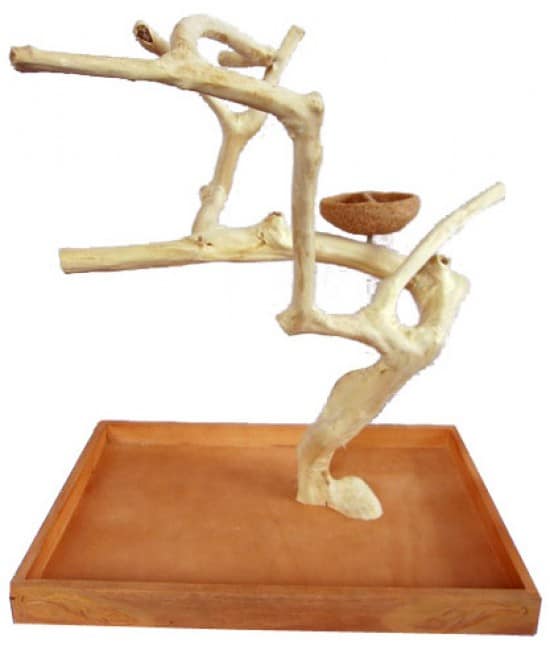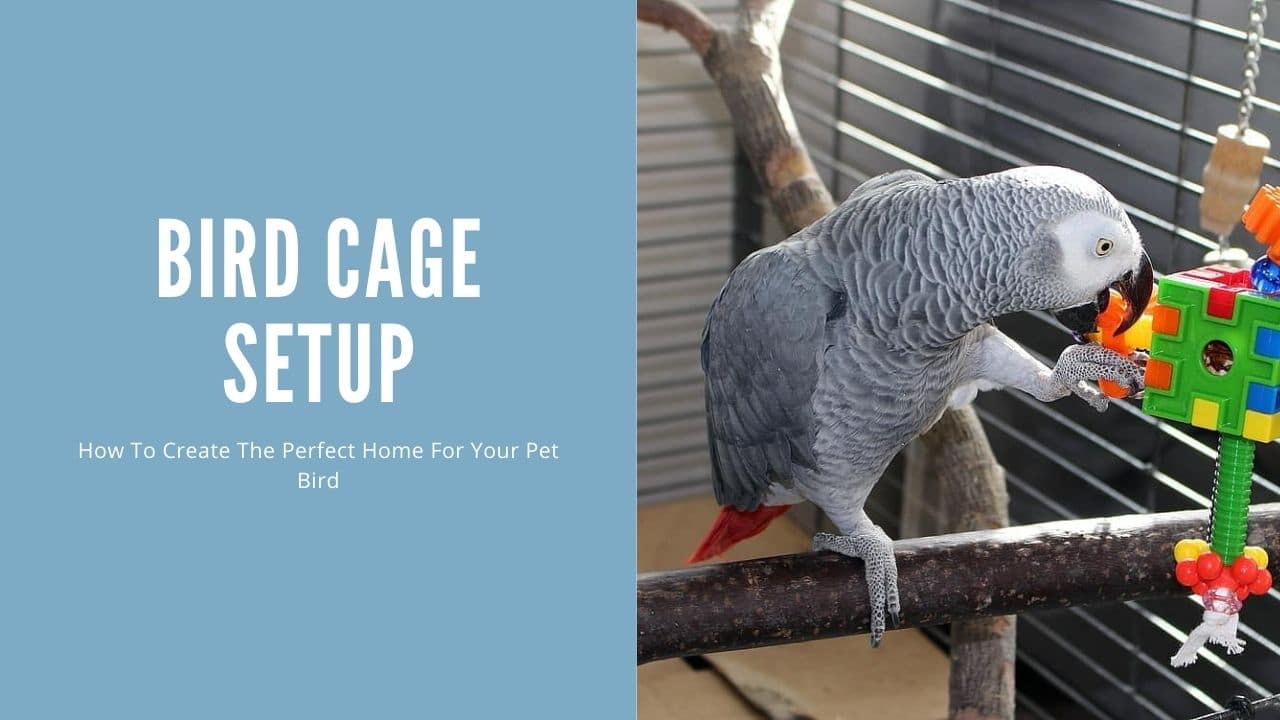Thank you for visiting! By the way… any links on this page that lead to products on Amazon and other stores/partners are affiliate links Aquarium Store Depot earns a commission if you make a purchase.
For pet bird owners, a bird cage purchase is a major decision when getting started . A proper bird cage setup is also a big consideration in order to make sure you have everything needed for your bird to be comfortable. A bird’s home should be safe, spacious, and have room for them to stretch their wings and play.
Today’s post I’m going to cover everything you need in order to setup a cage correctly. I will go through what to look for in a cage, talk about getting the proper bird perches, and what types of toys to purchase. Help with finding the right items to purchase, this post will contain affiliate links. An affiliate link means I may earn advertising or referral fees if you make a purchase through my link. With that disclosure out of the way, let’s get started
Types of Bird Cages
There are various types of bird cages on the market, and they all vary in quality. I will go over the most common you will find on the market.
Stainless Steel
This is the highest quality cage you will find on the market and also the most expensive. It is sometimes called “medical grade” , “marine grade”, or “304 grade”. This is the same stainless steel you will find in cookware and jewelry. The biggest advantage with stainless steel is its ease of cleaning. You don’t have to worry about paint chipping and you can use a putty knife to pull of bird poop and other waste off the cage. You usually see stainless steel cages in practice when it comes to a larger parrot cage.
Stainless steel bird cages offer ease of cleaning and durability. Great for larger birds!
Powder Coated
Power coated cages are one of the most popular cages you will find. They can be high quality or low quality depending on the manufacturing. Most are made of wrought iron then powder coats. The quality all comes down to the powder coat and the process. A high quality powder coat will be thick and will last many years. The coat should be bird proof. A poor quality coat will chip and rust over time. The ideal format for a bird cage is a Flight Cage variant.
Metal and Plastic
These are the economy cages you will typically see at a chain pet store. They are constructed of metal wires with a plastic base. The paint will usually chip easily and the metal cage bars tend to bend over time. As the paint chips, you will usually get rusting on the cage. These cages are best suited for smaller birds. They are usually undersized though. I usually do not recommend buying these cages even if you are on a budget.
Wooden
Wooden cages have been used for many years and tend to be expensive. You usually see them in use outdoors or in public zoos. You generally will not see these cages available for sale.
Acrylic
Acrylic Cages are one of the priciest cages you will find, but provides a clear view of your bird. They need to be planned out because they don’t allow for much ventilation and bars need to be planned out. Many of the best acrylic cages you can purchase are going to be custom made or made to order. It’s takes a lot of consideration and planning to purchase a great acrylic cage that fits your bird. Most people will not get one for that reason.
Sizes and Bar Spacing
The next consideration is proper size of the cage and bar spacing. To make this easy, I have provided the cage size minimums and bar spacing for several of the most popular pet birds in the trade today. Not that bar spacing will differ from bird species, which I have listed for your reference.
| Bird / Parrot Species | Cage Size (W x L x H) | Bar Spacing |
| Finches | 18″ x 30″ x 18″ | 1/4″ to 1/2″ |
| Canaries | 18″ x 24″ x 18″ | 1/4″ to 1/2″ |
| Budgies | 18″ x 18″ x 24″ | 1/2″ |
| Cockatiels | 20″ x 20″ x 24″ | 1/2″ to 5/8″ |
| Conures | 24″ x 24″ x 24″ | 5/8″ to 3/4″ |
| Lovebirds | 24″ x 24″ x 24″ | 1/2″ |
| Amazon Parrots | 24″ x 36″ x 48″ | 3/4″ to 1″ |
| African Greys | 24″ x 36″ x 48″ | 3/4″ to 1″ |
| Cockatoo | 36″ x 48″ x 48″ | 1″ to 1.5″ |
| Macaws | 36″ x 48″ x 60″ | 1″ to 1.5″ |
Perches
Perches are just as important as a proper cage. Your bird will be on its free all day. Improper perches will create long-term problems for for your birds feet over time. The standard perches called “Dowels” are not suitable for birds. This because they do not mimic the natural branches they perch on in the wood. While they are easy to place and clean for us humans, they provide no exercise for our birds. The constant pressure and imbalance of being in the same position will also create sores and infections. This condition is known as bumblefoot and is very painful to your bird.
So let’s talk about what perches are best for your bird. These would be:
- Natural Wood Perches
- Rope Perches
- Flat Perches
Natural Wood Perches
The best perches to buy are natural wood perches. They come from real hardwood trees or shrubs and offer a variety of diameters and variations needed for your bird. There are multiple types of natural wood bird perches available, but I feel these three are the best out there to purchase. They would be:
Budget Option
Manzanita offers great value and variety as a bird perch. A best buy!
- Java Wood
- Manzanita Wood
- Bottlebrush
Java wood offers the most variety in diameter. Manzanita wood is domestic and offers great value. Bottlebrush offers the simplicity of the dowel perches, but with the variety needed for your birds feet.
Rope Perches
Rope perches offer variety and can be shaped to suit the spacing of your cage. The main thing to be careful of is some birds like to chew on them. You will need to watch for the fibers if they chew on them. If you have a bird that leaves them alone, it is a great option for a perch.
Flat Perches
Flat bird perches give your bird a break on their feet to rest. Every cage should have one and most are designed to fit in corners of the cage.
Toys

Bird toys are not optional accessories for a cage. They are vital for your pets. Birds are intelligent pets that need to stay active. If they get bored or depressed, they will go into self multination or scream for your attention. You need to offer your bird a variety of toys they find entertaining and rotate them out so they don’t get bored of playing with the same toys. Here are a few examples of great pet bird toys to try:
- Rings
- Ladders
- Bird Kabobs
- Finger Traps
The bird kabob itself is one of my personal favorites. Most birds go crazy for them and tear them apart. They are made of soft fibrous pithy wood. Hookbill birds like Cockatiels and Bungies just can’t resist them.
Play Stands

While many cages will actually come with play stands. You may want to have a separate play stand in another room or in several rooms for your bird to move around. Most play stands are simple and will work on a desktop. There others like the one made by A&E above that are designed to be free standing and are very natural for your bird to perch and play on. You should always supervise your bird on the stand until you are familiar with the behavior of them. Some birds won’t leave their stand while others do enjoy to explore. Also, loud noises can scare the bird into flying so always be present. Most play stands will have food and water cups. You should always supply this to ensure your bird doesn’t get hungry.
Feeding Cups
Many discount cages will come with plastic cups. Plastic cups are not ideal for a cage for multiple reasons. The main reason is they are a hotspot for bacteria to grow. They also are scratched easily and are not very study. They can work in the short-term, granted you regularly check them for scratches and replace them when they become worn out.
I would recommend that you invest in stainless steel cups and purchase a couple of sets so you one set on standby when you are disinfecting the other. Stainless steep cups won’t house bacteria and are easily disinfected. They last much longer and have the bulk to handler larger and more active birds.
It is a best practice to place your water bowl over the feeding bowl or to have them on opposite sides of the cage. This ensures a cleaner cage.
Lighting
This is one of the most overlooked aspects of proper bird care. If your birdcage does not receive any natural sunlight lighting is something you are going to need to add. This is not some fancy add-on but rather an essential for a bird. The only pet birds on the market that do not need lighting would be Amazon parrots and blue macaws.
The reason why is all other birds have a uropygial gland. This gland secretes oils which are distributed by the bird rubbings its beak and head against the gland opening. This oil not only waterproofs your bird, but also provided Vitamin D3. Without proper sunlight, your bird will become vitamin deficient and become ill.
Birds are also photosensitive. Their biological clocks are tune by the amount of sunlight they received. Too much light and your bird may start laying too many eggs or become aggressive. Knowing what these changes in sunlight can do will allow you to tune your their light needs as needed.
For bird lighting, there are specialized lights available that are full spectrum and will stimulate a natural photoperiod. The only brand I recommend is M&M Cage Company’s LED Pet Lamps. They are available with chew guards and designed to take a beating. A light can do wonders for a bird. Parrots may start to eat healthier foods they never ate before, scream less, and are less fussy. Canaries and finches will often sign more and be more active under proper lighting conditions.
Covers
A cage cover isn’t a necessary accessory, however, it can be a vital item if your sleep and wake schedule is different than the natural day and light cycle outside. Birds will wake up as soon as dawn and not everyone wants to wake up at dawn. Another reason could be where you live. If room gets drafty or cold at night, the bird cover will help insulate the temperatures in the cage. This is a big factor to consider if you live in a colder area.
If you choose to purchase a cage cover, make sure you stick to the routine. Your bird will expect you to cover the cage at night around the same time every evening. Also keep in mind that not every bird is a fan of the cover. Some birds do get night frights. If your bird is one of those, consider a nightlight.
Seed Guards
A seed guard as known as a bloomer can really help keeping your floors clean. Pet birds are messy and while some cages will come with a seed shirt, many do not. There are some things you can do to migrate the mess as well:
- Purchase a bird cage mat. These mats are waterproof and non-slip. They are easy to clean and machine washable
- Keep a broom and dustpan near the cage. Even better if you purchase an handheld vacuum cleaner to pick up quick messes
- Invest in heavier food and water bowls to keep your bird from tossing everything out of it
How To Setup
Here are a few tips to on how to place your perches and toys:
- Scatter and space apartment perches
- Make sure the perches are laterally spaced so your bird has space to fly around.
- Start with the biggest highest reaching perches first. Try to place the weirdest shapes first and at the top.
- Do not overlap bird perches. Overlapping will cause issues with cleaning as bird droppings will land on the bottom perches if they are right underneath others
- Do not clutter the center space – remember we want to give lateral space to allow your bird to fly and climb around
- Place toys near perches so your bird can play with them, but always keep the center open
- Change toys often so your bird doesn’t get bored
- Stick with stainless steel food and water bowls for the cleanest cage
- Go with newspaper or cage liner. Newspapers are best, but these days folks are not getting newspapers as much. Get cage liner if you don’t have access to newspapers. Standard newsprint paper is best for newspapers not magazine or periodicals. Amazon sells newsprint paper in bulk that work very well for this purpose
Placement
Your bird is part of your family. It is absolutely essential to have them placed in a high traffic area. Family rooms, living room, or near kitchen are usually going to be the best. Be very careful if you are considering placing your bird need the kitchen as they are very sensitive to fumes. Non-stick pans, toaster ovens, and irons can all emit fumes that can be toxic to your bird.
While high traffic areas are great for birds, you will want to avoid areas near a door that is opening and closing. This can create a lot of disruption for them. You will also want to keep them away from noisy rooms. You will want an area near a natural sunlight source, but not in direct sunlight.
You will also want to place the cage in an area where it can only be views from 3 sides. This will make your bird feel less exposed. Placing the cage against a wall is a good idea to ensure a 3 point view.
Never place a birdcage directly on the floor. Birds are used to being at high points in the wild to get a full view of their surroundings. They want the same comfort level in their cage. This is why many quality cages will come with stands.
Make sure you do not place your cage in front of a heater or AC vent. They do not tolerate direct drafts well. Keep cords out of view of your birds. Some birds like to nibble on power cords, which can lead to nasty consequences.
How To Clean
I’ve seen a lot of tutorials that cover the basics when it comes to cleaning a cage. However, I want to go over proper sanitizing for a bird cages. This is something you want to do regularly instead of the usual maintenance to ensure your cage is clean and healthy for your bird. This video by The Tech Genie is a great video that shows you the proper way to sanitize and clean out your cage the right way. Make sure you use two different types of towels and sponges when cleaning. A steam cleaner is your best friend as they naturally disinfect and are easy to use.
Other regular maintenance tasks would include
- Changing the paper every day or every other day. Waiting too long will allow for harmful bacteria and fungus to grow that can be harmful to your pet bird
- Never use chemical cleaning solution when cleaning a bird age
- Clean your perches with hot soapy water and make sure it dries out
- Replace toys as they wear out
Closing Thoughts
A proper cage setup will is a solid foundation for a pet bird. It is a place to rest and be comfortable in when you are around and at night. It prompts health and well-being. Have any thoughts you want to share? Leave them in the comments below. Thanks again for reading!
- About the Author
- Latest Posts
I’m thrilled that you found Aquarium Store Depot! Here you’ll find information on fish, aquariums, and all things aquatics related. I’m a hobbyist (being doing this since I was 11) and here to help other hobbyists thrive with their aquariums! I adhere to a high quality Editorial Process and Review products with real life field usage and practical analysis.







